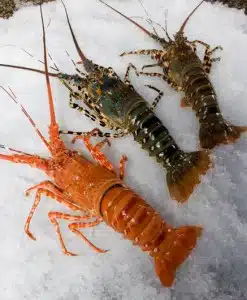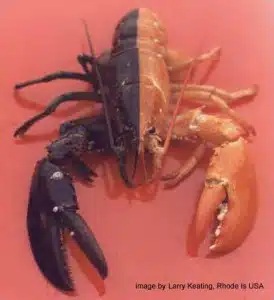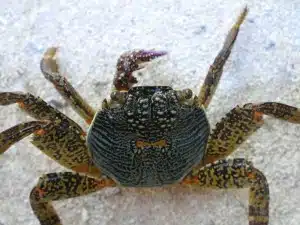A team of Queensland researchers have discovered that lobsters, prawns and other crustaceans have evolved a unique way of making colours: making the complex patterns appreciated by biologists and connoisseurs of seafood.

Dr Nick Wade during his PhD research on the western rock lobster, Panulirus cygnus. Photo credit: Nick Wade, UQ.
Their work will help with conservation, aquaculture and may even lead to a new food colourant. And all the colours come from just one molecule.
The colour of seafood is directly linked to its acceptability as food. Highly coloured lobsters and prawns attract a premium price. And for the crustaceans themselves, it’s a matter of survival.

The intricate shell patterning and colouration of the tropical rock lobster, Panulirus ornatus. Photo credit: Nick Wade, UQ.
So, whether you are working in the world’s US$38-billion crustacean fisheries or part of the catch, the work of Dr Nick Wade and colleagues at the University of Queensland (UQ) and Australian Institute of Marine Science (AIMS) is significant. They have identified the underlying genetics that explains the way in which crustaceans produce their wide range of shell colours. Their research was published this week in the Journal of Molecular Biology and Evolution.
“This knowledge of how crustaceans produce and control colour helps us understand the genetic diversity and evolution that underpins this group of highly successful group of animals,” Nick says, “as well as benefit the future development and sustainability of the aquaculture industry.”
In order to be coloured, all crustaceans must consume the same small molecule known as a carotenoid. They occur widely in nature: in photosynthetic bacteria, algae and plants such as carrots and capsicums.
Crustaceans use the bright red carotenoid astaxanthin bound to a protein, called crustacyanin. This protein modifies the carotenoid wavelength to any other colour in the visible spectrum. “Apart from crustaceans, no other animals we analysed had the crustacyanin gene”, says Nick. “Therefore, we now know that crustaceans have evolved a unique way of using this simple carotenoid building block to produce all their colours”, he says.
“This protein is used only by crustaceans to create their intricate and diverse shell colour patterns”, says Nick, “providing protective camouflage or communication which, in turn, may have contributed to the success and diversification of their group”. But the coloured protein complex can be easily disrupted, as we see when we cook prawns, crabs or lobsters, and the original red carotenoid is released producing the colour we associate so strongly with cooked seafood.
When bound to protein, the normally fat soluble carotenoid also becomes strongly water soluble, providing a potential application for these compounds as natural food colourants. Other uses could include coloured heat or pH indicators.
Reference: Nick Wade, Alina Tollenaere, Mike Hall and Bernard Degnan, Evolution of a novel carotenoid binding protein responsible for crustacean shell color, Molecular Biology and Evolution, published August, 2009. This research was conducted as part of an Australian Research Council Linkage grant.
Contact Nick on +61 (438) 137 661, Nick.Wade@csiro.auNick Wade, now a researcher with the CSIRO Food Futures Flagship, is one of 15 early-career scientists presenting their research to the public for the first time thanks to Fresh Science, a national program sponsored by the Federal Government.
For Fresh Science contact: Sarah Brooker on 0413 332 489 and Niall Byrne on 0417 131 977 or niall@freshscience.org. For images and background visit www.freshscience.org
Header: A rare colour mutation in clawed lobsters demonstrates the importance of genetics in crustacean shell colour formation. Photo credit: Larry Keating (Rhode Island USA).
Creating Colour: Crustacean Style: background information
Have you ever been fascinated by the colour change we observe when we cook up some lovely seafood? Why that beautiful blue prawn or green crab turns a wonderful scarlet red colour when cooked, a colour we associate so strongly with healthy, tasty seafood?
Well, as it turns out, all these colours and the intricate shell colour patterns of crustacean shells are produced by one protein, one that is unique to this group of animals.
Colour in crustaceans is produced by the interaction of a carotenoid, called astaxanthin, with a protein known as crustacyanin.
More than 600 carotenoids are known in nature, and they split into two broad categories: the carotenes (oxygen free) and xanthophylls (containing oxygen).
In humans, carotenoids such as beta-carotene are a precursor to vitamin A, a pigment essential for good vision, and carotenoids can also act as antioxidants.
The colour of carotenoids ranges from pale yellow to bright orange and deep red and is directly linked to their structure.
Within the crustacyanin protein complex, astaxanthin gets twisted or distorted to produce a shift in its wavelength from red to any other colour in the visible spectrum.
Upon cooking, the complex is disrupted and the red astaxanthin molecule is released once again, changing the colour of the animal to the one we so strongly associate with seafood.

Natural colour of the tropical rock lobster, Panulirus ornatus, and the colour change when cooked due to the release of the red carotenoid from the crustacyanin protein. Photo credit: CSIRO Food Futures Flagship
Crustacyanin and the shell colour of lobsters has been the topic of scientific research for more than 100 years.
Previous research focused on extracting and purifying crustacyanin directly from lobster shells.
It had been established that crustacyanin was a 25 kDa protein with a number of distinct forms.
The 3-dimensional crystal structure of this protein has also been resolved.
Crystals of this protein were even formed in an experiment in space.
Two crustacyanin proteins are known to combine with 2 astaxanthin molecules to form the purple b-crustacyanin complex.
Indeed, the high molecular weight complex known as a-crustacyanin, which is blue, is composed of eight b-crustacyanin subunits.
Carotenoids are unable to be produced by most higher animals and thus form an important component of the crustacean diet.
Using a combination of molecular biology techniques and bioinformatics, the former University of Queensland PhD student and his colleagues searched for the presence of crustacyanin across a wide range of animals, identifying it in a only a subset of crustaceans.
The protein was only present in those animals that we would all easily recognise as crustaceans (crabs, lobsters, prawns etc).
This study identified the 2 genes encoding the two crustacyanin proteins in a range of Malacostracan crustacean representatives.
A total of 13 novel sequences were identified across 8 different crustacean species, and represent the first crustacyanin gene sequences identified.
Across other members of the animal kingdom, these genes could not be identified in targeted molecular genetic approaches or from searches of 13 currently sequenced genomes, including the distantly related insects or the water flea Daphnia, a more closely related crustacean.
This provides evidence of a gene duplication event in the early crustacean ancestor, and co-option of this duplicated gene into a new role in shell colouration.
The sequences identified revealed that the protein itself had evolved, over a long period of time, to form a specific subgroup within a much larger functionally diverse protein family: the lipocalins.
Analysis of the tissue beneath the hard exoskeleton showed that specific expression of the crustacyanin genes was responsible for the intricate shell patterns and range of colours we observe in crustacean shells.
As such, we have demonstrated that certain crustaceans have exclusively evolved the ability for crustacyanin to produce a full spectrum of colours using a simple single coloured carotenoid as the basic building block.
Our research demonstrates a strong genetic effect underlying crustacean colouration and reveals the genetic basis of its complexity.
The ability of crustaceans to modify their colour in this way has had a profound influence on the success of this group of animals throughout evolution.
In turn, these factors are known to have an effect on camouflage, predation, mate selection and communication in many crustaceans.
This research also has many applications for the Australian and worldwide aquaculture industry, as the value of the product is highly dependent on the colour.
In the future, research will focus on the ability to induce animals in aquaculture to become more colourful more quickly, reducing costs and boosting product value an
d acceptability.
Further uses include producing a natural series of water soluble food dyes that also deliver the beneficial health effects of astaxanthin, or colour indicators for heat or pH would also be possible.
Alternatively, if you ever imagined owning a purple polka-dot crab or lobster as a pet, then this might be the time to ask.





 Fresh Science is on hold for 2022. We will be back in 2023.
Fresh Science is on hold for 2022. We will be back in 2023.
4 Comments
WALTER LEWIS
21 May 2014 at 7:22 amATTN: Nick Wade
Congratulations on the work you have done on Lobster colours.
What I am interested is is whether you think that a food with a colourent
could assist in changing the lobster from Orange to a reddish .
Kindly advise
Walter
Andrewtix
20 July 2020 at 1:35 pmотрадный сайт https://bet2much.ru/
Richarddrymn
9 August 2020 at 11:36 amvisit this site right here https://hydra2020gate.com
Brianmoorm
6 October 2020 at 10:30 amфартовый ресурс
1 хбет мобильная версия